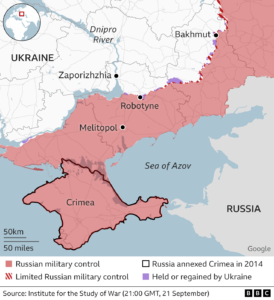 BY DAVE GUTKNECHT
BY DAVE GUTKNECHT
Here’s NATO and some of the U.S. imperial agenda: expansion to Russia’s borders and now in Africa, wars in Serbia, Libya, Syria, and Afghanistan’s nearly one million dead almost forgotten already.
Sixty years ago, the lesson of the Cuban missile crisis was not that we faced down the USSR, but rather that there was mutual recognition of security needs, hence the withdrawal of U.S. missiles from Turkey. That was not discussed, however, and today we suffer the same denial that other nations’ interests are equal to ours.
Wars often require a big lie, and for Ukraine the big lie is that the Russian invasion was “unprovoked”—overlooking years of planning and provocation by the U.S. After the 2014 coup, the U.S. stepped in to prevent a 2015 settlement to end the war and keep Ukraine intact—and the U.S. stopped a settlement again in March 2022.
The 2015 Minsk agreements—which Germany’s Merkel and France’s Hollande recently admitted they did not try to enforce, but instead used to prepare Ukraine for war—were followed by eight years of bombardment of Russian-speaking eastern Ukraine, causing 14,000 deaths and culminating in a military buildup precipitating this larger war. Unfortunately, that 2015 compromise, which would have protected rather than persecuted Russian speakers and culture in Ukraine, is no longer available.
Earlier this month, speaking at the European Parliament, NATO Secretary-General Stoltenberg acknowledged that it was the U.S. relentless drive to expand NATO that was the cause of this war. U.S. planners wanted war on Russia, with Ukraine the sacrificial proxy.
The Ukrainian counter-offensive, heralded for months beforehand, has accomplished little beyond the slaughter of many thousands and enormous destruction. U.S. and European officials hint that the West is running low on everything but promises. In columns dating back to January (https://southsidepride.com/2023/01/28/a-response-to-sspride-ukraine-columns/), I have recommended commentary outside the mainstream: Jeffrey Sachs and John Mearsheimer; ConsortiumNews.com; veterans Ray McGovern, Scott Ritter and Douglas Macgregor; ex-diplomats Alastair Crooke and Craig Murray; European reporters Alexander Mercouris and Alex Christoforou; and local “Veterans for Peace News.” I hope none of these dissidents have their media platforms, following guidance from Washington, marginalized and even banned.
Our anti-Russia campaign is broken, and stunning political dysfunction here will add to demands for an end to the Ukraine war. Our own country is where we have the most responsibility and opportunity to press for change, and it is still the number one source of war and violence in the world—as we, with Martin Luther King, concluded in 1967.
Arguments in favor of a cease-fire
BY ED FELIEN
On Oct. 17, the Wall Street Journal reported: “With Ukraine’s counteroffensive making slow progress, Russia launched a large-scale assault on the eastern city of Avdiivka last week. Kyiv said it resulted in heavy losses for Russia, showing how difficult it is for either side to move the frontline.”
The front lines haven’t moved much for the last six months. It looks like a stalemate. Each side has tried offensives, and each side has sustained tremendous casualties. Both sides are recruiting mercenaries from the Global South. It is beginning to seem like senseless slaughter.
We have supported Ukraine’s right to defend itself from Russian aggression, but at this point it seems that even with U.S. and European military support Ukraine will not be able to drive out the invaders.
Let’s review the history:
Russians and Ukrainians date their origin to Oleg, the Viking, seizing Kyiv in 882. They called themselves the Kievan Rus, and their lands stretched through Belarus and most of Russia. In 1240 the Mongol invasion ended that dynasty, and the lands east of the Dnipro River now belonged to the Great Khan. Russia paid yearly tribute until 1480 when they became independent under the czars.
Russia claims Ukraine was always part of Russia. Ukrainians believe the Viking/European claim is older.
Ethnic demographics suggest strong Russian language and cultural references east of Dnipro and strong European influence to the west. Donetsk is 87.8% Russian and only 11.1% Ukrainian. The province of Luhansk is about 50/50.
The current problems began with the Maidan Uprising in November of 2013. They were protesting President Yanukovych’s refusal to sign the agreement for Ukraine to join the European Union. There had been an informal agreement in Ukrainian politics that the west got to control the Parliament and a Russian could be president, or a Russian could control Parliament and a western Ukrainian could be president. Yanukovych was prime minister many times between 2002 to 2007 before he became president in 2010. It is important to note that Paul Manafort, Trump’s campaign chief from May to August of 2016, spent a decade as a consultant to Yanukovych—fees probably paid by the Russian government.
Yanukovych had agreed to sign on to the European Union agreement, but after consultations with Moscow he changed his mind. Demonstrations drove him out of the country. In February and March of 2014 Russia invaded and occupied Crimea and Donetsk. The world’s reaction was a lot of sound and fury and some sanctions but signifying so little that Putin felt comfortable waging a full-scale invasion of Ukraine on Feb. 24, 2022. So confident were they of victory that the tank convoy going from Belarus to Kyiv had little in the way of provisions, but they did have fancy dress uniforms for a victory parade.
Most advances by the Russians were easily beaten back, but they have held on stubbornly to territories on the western shore of the Azov Sea from Donetsk and Luhansk down to Mariupol.
What should be done?
We must continue to support Ukraine in its struggle against Russian aggression, but maybe we should start talking to the Ukrainians about a cease-fire.
























